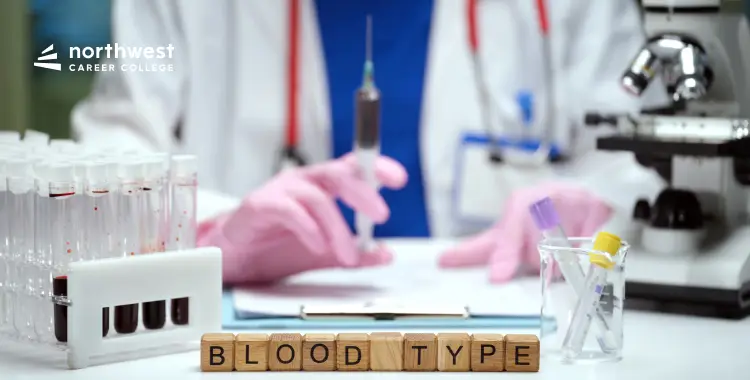Top 5 Skills Phlebotomy Students Learn During Blood Donation Events
- November 4, 2025
- 1.1k views
- 4 min read
Every two seconds, someone in the U.S. needs blood. Blood donations are essential in saving lives, from surgeries and cancer treatments to chronic illnesses and emergency care. Every donation, whether whole blood, red cells, platelets, or plasma, starts with someone willing to help.
For a phlebotomy student, blood donation events are more than just drawing blood from donors; they’re a transformative learning experience. Blood donation events offer the opportunity to learn hands-on, real-world skills, boost confidence, and positively impact the lives of others.
With up to 6.8 million donors donating annually, it’s where you want to be and experience what it truly takes to be part of healthcare, one stick and one patient at a time.

Table of Contents
How to Prepare and Greet Donors
One of the first skills phlebotomy students learn during blood donation events is how to welcome donors properly. This step sets the tone for the entire experience, starting before the needle emerges.
Staying Calm and Professional
Donors can be nervous, especially first-timers. That’s why students are taught to stay calm, focused, and reassuring. A steady, professional attitude helps ease anxiety and shows that the team is ready and confident. It also teaches students how to manage their nerves while working under pressure.
Checking IDs and Paperwork
Before a donation can begin, all documents must be in order. Phlebotomy students learn to review forms, verify photo IDs, and ensure the donor has signed all necessary consent paperwork. This step is essential not just for safety but also for keeping the event organized and running smoothly.
Building Trust Through Communication
Trust begins with a warm greeting and a respectful tone. Students practice asking health-related questions clearly and with empathy. You are trained to listen carefully, make eye contact, and explain what to expect during the process. These small communication habits help donors feel seen, respected, and more at ease.
Performing a Safe and Successful Venipuncture
Safely performing venipuncture is crucial for phlebotomy students during blood donation procedures. You will be instructed on assessing the arm, choosing the appropriate vein, usually the median cubital, and the correct angle and technique when placing the needle.
Another high-priority task is keeping the environment clean and aseptic, starting with hand hygiene, new gloves, and appropriate site preparation. These actions prevent infection and contribute to the donor’s comfort and safety.
Monitoring Donors During and After the Collection
Once the blood draw begins, the work barely gets started. That’s when close monitoring becomes most helpful. Phlebotomy students are instructed to observe donors discreetly for signs of pain, dizziness, or other issues. Seeing and observing are the essentials here.
A pale face, a shaking voice, or even a body shift can indicate something’s out of order. The students learn to respond gently but promptly, frequently interrupting the draw or giving extra support.
After the donation, you’ll guide donors through recovery, encouraging them to rest, giving them snacks, and reminding them to drink fluids. In a small but significant way, part of the process informs donors that they’re being cared for as people.
Handling Blood Samples Properly
Once the blood samples have been collected, the process continues out of sight. Phlebotomy students are taught to handle every sample carefully, beginning with appropriate labeling. For future easy identification, every tube must be accurately labeled using the information of the donating individual.
The students are also instructed on placing samples into transport bags for safe and proper storage, keeping them secured until they enter the lab. A minor mistake, like a smeared label or tube out of place, can affect test results or delay processing, so it’s the little things here.
Staying Organized in a Busy Setting
Blood donation events can be chaotic, with various donors, ticking clocks, and equipment and supplies always on the go. This atmosphere can be overwhelming. That’s why phlebotomy students are taught to remain level-headed and organized regardless of how hectic it becomes.
You’ll become comfortable working efficiently but never rushed, finding a balance between speed and completeness through repetition, having supplies readily accessible, replenishing supplies, and discarding correctly will become second nature.
Most importantly, students become comfortable sitting comfortably focused, no matter what chatter goes on around their space, and donors wait for their turn. Staying relaxed and competent is more than a question of expediency. The result is a seamless, safe experience for all concerned parties.
Conclusion
Blood donor sites teach students more than how to perform procedures for drawing blood; they are where students become competent, confident phlebotomists. In the workplace, students gain speed, master technical skills, and learn to interact personally. The hands-on training translates the theory into real-world preparation.
Ready to learn these skills in action? Enroll now at Northwest Career College’s Phlebotomy Technician Program and get the training and experience you need to succeed in phlebotomy.




